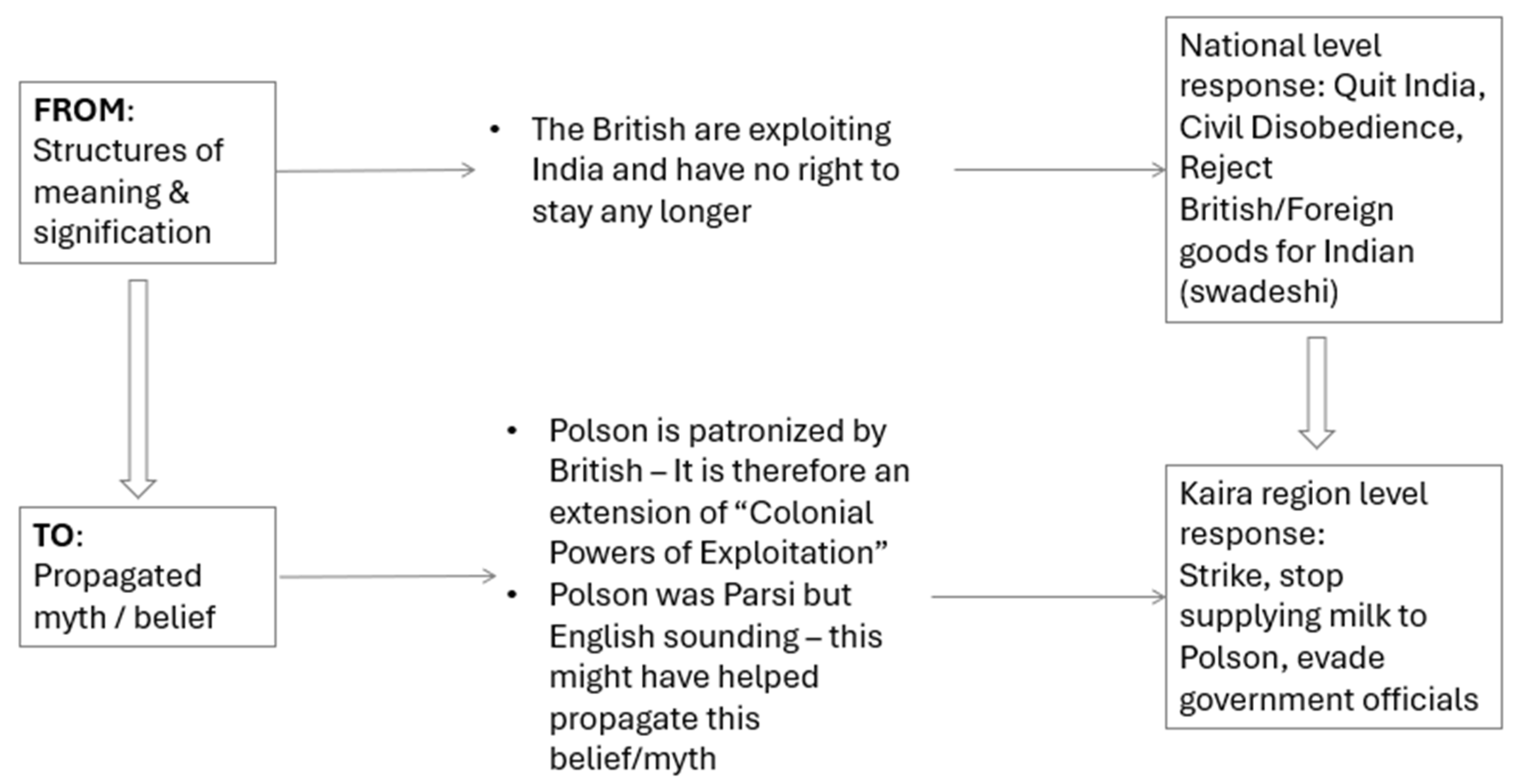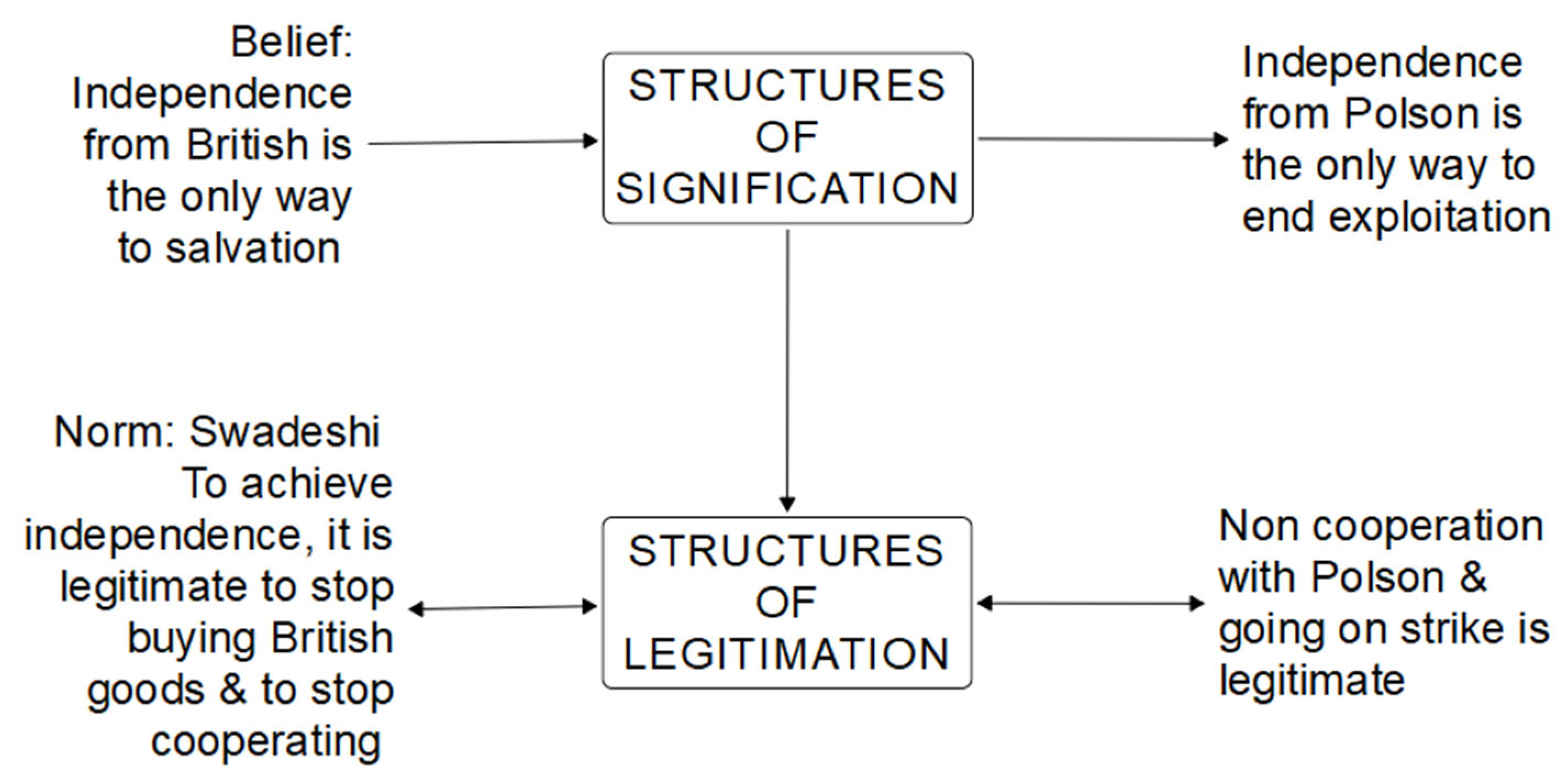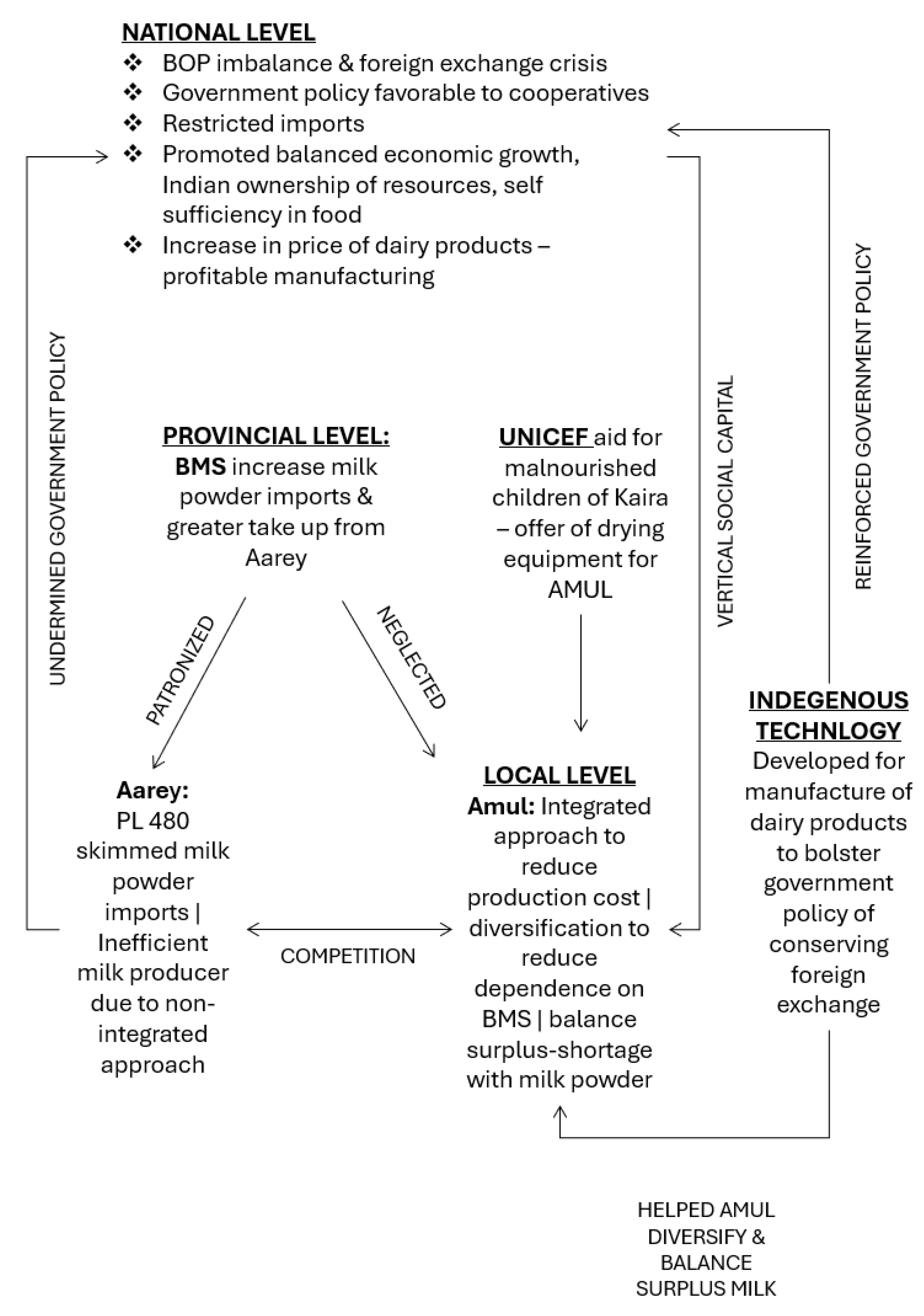The Emergence of a Cooperative Amidst Economic Disruption: A Historical Narrative of Amul Coop in India
Abstract
1. Introduction
2. Background Research on Cooperatives
3. Historical Analysis: Emergence and Strategy Formation of Amul
3.1. Methodology
3.1.1. Study Location & Sample Selection
3.1.2. Study Design
3.2. A History of Self-Organization and the Introduction of Economic Disruption
3.2.1. Prior Emergent Movements: The Satyagrahas of the 1920s and 1930s
3.2.2. Economic Disruption in the Milk Sector in the 1940s
“Before Kaira Union (AMUL) supplied to the Bombay Milk Scheme, and before Polson came into the district, farmers would make Ghee to sell to private traders and they would consume the by-product butter milk in their homes. The producers had to sell their Ghee at whatever prices were offered by the traders. However, once Polson set up the dairy business in Anand, milk was collected from individual farmers by contractors.”
“Polson had milk contractors working as agents. Polson did not have any personal contacts with the milk producers. So, a contractor would collect milk from say 100 milk producers and he (contractor) would keep some 5 “Agyavan” (overseers) happy and influence them by giving them good prices so that they in turn would influence the other farmers in their village to supply milk to the contractor. They (contractors) would however give lower prices to these other producers and exploit them. So, these malpractices made them and Polson unpopular…. At that time, Polson was the most important milk purchaser…if any one person could supply milk to Bombay city in bulk, only Polson could. There was no other alternative”.(Interview)
3.3. Explaining the Phenomenon of Emergence
3.3.1. Theoretical Approach: Giddens’ Structuration Theory
3.3.2. Using Structuration Theory to Explain Emergence of AMUL
“Yes, but indirectly. Indirectly they were exploiting the farmers by way of their economic structure. The likes of Polson were controlled and patronized by the British and they used to exploit people to obtain raw materials at the lowest cost. Colonization was the basic structure. The Governor of Bombay was a Britisher”.
3.3.3. Using the Panarchy Framework to Explain the Emergence of AMUL
3.4. Sustaining a Cooperative: Early Strategy Formation, Expansion, and Diversification
4. Discussion and Conclusions
Limitations and Scope for Further Research
Author Contributions
Funding
Institutional Review Board Statement
Informed Consent Statement
Data Availability Statement
Conflicts of Interest
| 1 | Edulji was affectionately known as Polly, and to bring into effect a British-sounding name, he decided to name his brand Polson (Sethu, 2021), Source: https://thebetterindia.com/250114/polson-butter-pestunji-edulji-dalal-khaira-dairy-bombay-milk-scheme-amul-butter-pre-independence-div200/ (accessed on 27 December 2024). |
| 2 | Khurody would eventually go on to become the Bombay Milk Commissioner after India’s independence. |
| 3 | https://www.amuldairy.com/t_k_patel.php (accessed on 27 December 2024). |
References
- Alderman, H., Mergos, G., & Slade, R. (1987). The history of AMUL, the dairy cooperative movement, and operation flood: A literature review. Available online: https://cgspace.cgiar.org/server/api/core/bitstreams/7645795f-b1c8-4ae7-9b14-2a702565856c/content (accessed on 27 December 2024).
- Amul Dairy History. (2024, December 27). Milk, The inspiration behind a revolution. Available online: https://www.amuldairy.com/history.php (accessed on 27 December 2024).
- Argyres, N. S., De Massis, A., Foss, N. J., Frattini, F., Jones, G., & Silverman, B. S. (2020). History-informed strategy research: The promise of history and historical research methods in advancing strategy scholarship. Strategic Management Journal, 41, 343–368. [Google Scholar] [CrossRef]
- Bates, C. (1981). The nature of social change in rural Gujarat: The Kheda district, 1818–1918. Modern Asian Studies, 15(4), 771–821. [Google Scholar] [CrossRef]
- Baum, J. A. C., & Dutton, J. E. (Eds.). (1996). The embeddedness of strategy. In Advances in strategic management (Vol. 13). JAI Press. [Google Scholar]
- Bettis, R. A. (1991). Strategic management and the straightjacket: An editorial essay. Organization Science, 2(3), 315–319. [Google Scholar] [CrossRef]
- Boone, C., & Özcan, S. (2014). Why do cooperatives emerge in a world dominated by corporations? The diffusion of cooperatives in the US bio-ethanol industry, 1978–2013. Academy of Management Journal, 57(4), 990–1012. [Google Scholar] [CrossRef]
- Brennan, L. (1984). The development of the India Famine Codes: Personalities, policies and politics. In B. Currey, & G. Hugo (Eds.), Famine as a geographical phenomenon [GeoJournal library, vol. 1 (Illustrated ed.)] (pp. 91–110). Springer. ISBN 90-277-1762-1. [Google Scholar]
- Brissenden, C. H. (1952). The bombay milk scheme. International Journal of Dairy Technology, 5(2), 108–114. [Google Scholar] [CrossRef]
- Brown, A. D., & Thompson, E. R. (2013). A narrative approach to strategy-as-practice. Business History, 55(7), 1143–1167. [Google Scholar] [CrossRef]
- Brown, L. H. (1985). Democracy in organizations—Membership participation and organizational characteristics in United-States retail food co-operatives. Organization Studies, 6(4), 313–334. [Google Scholar] [CrossRef]
- Bruton, G. D., Ahlstrom, D., & Li, H.-L. (2010). Institutional theory and entrepreneurship: Where are we now and where do we need to move in the future? Entrepreneurship: Theory and Practice, 34(3), 421–440. [Google Scholar] [CrossRef]
- Burgelman, R. A. (1983). A process model of internal corporate venturing in the diversified major firm. Administrative Science Quarterly, 28(2), 223–244. [Google Scholar] [CrossRef]
- Carroll, G. R., Goodstein, J., & Gyenes, A. (1988). Organizations and the state—Effects of the institutional environment on agricultural cooperatives in Hungary. Administrative Science Quarterly, 33(2), 233–256. [Google Scholar] [CrossRef]
- Chatterjee, I., Kunwar, J., & den Hond, F. (2019). Anthony giddens and structuration theory. In Management, organizations and contemporary social theory (pp. 60–79). Routledge. [Google Scholar]
- Chawla, H. (2007). Amul India: A social development enterprise. Asian Case Research Journal, 11(2), 293–326. [Google Scholar] [CrossRef]
- Cook, M. L. (1995). The future of U.S. agricultural cooperatives: A neo-institutional approach. American Journal of Agricultural Economics, 77(5), 1153–1158. [Google Scholar] [CrossRef]
- Dacin, M. T., Ventresca, M. J., & Beal, B. D. (1999). The embeddedness of organizations: Dialogue & directions. Journal of Management, 25, 317–356. [Google Scholar]
- Daft, R. L., & Lewin, A. Y. (1990). Can organization studies begin to break out of the normal science straitjacket? An editorial essay. Organization Science, 1(1), 1–9. [Google Scholar] [CrossRef]
- Dandi: Salt March. (2009, October 11). Available online: http://southasia.ucla.edu/history-politics/gandhi/dandi-march/ (accessed on 27 December 2024).
- den Hond, F., Boersma, F. K., Heres, L., Kroes, E. H., & van Oirschot, E. (2012). Giddens à la Carte? Appraising empirical applications of Structuration Theory in management and organization studies. Journal of Political Power, 5(2), 239–264. [Google Scholar] [CrossRef]
- Denis, J. L., Langley, A., & Rouleau, L. (2007). Strategizing in pluralistic contexts: Rethinking theoretical frames. Human Relations, 60(1), 179–215. [Google Scholar] [CrossRef]
- Desai, D. K., & Narayanan, A. V. S. (1967). Impact of modernization of dairy industry on the economy of Kaira district. Indian Journal of Agricultural Economics, 22(3), 54–67. [Google Scholar]
- DiMaggio, P. J., & Zukin, S. (1990). Structures of capital: The social organization of economic life. Cambridge University Press. [Google Scholar]
- Dixit, M. R. (2014). Amul–2014 (pp. 1–60). Indian Institute of Management Ahmedabad. [Google Scholar]
- Eisenhardt, K. (1989). Building theories from case study research. Academy of Management Review, 14(4), 532–550. [Google Scholar] [CrossRef]
- Estrin, S., Mickiewicz, T., & Stephan, U. (2013). Entrepreneurship, social capital, and institutions: Social and commercial entrepreneurship across nations. Entrepreneurship Theory and Practice, 37(3), 479–504. [Google Scholar] [CrossRef]
- Etzioni, A. (1967). Mixed-scanning: A “third” approach to decision-making. Public Administration Review, 27(5), 385–392. [Google Scholar] [CrossRef]
- Fenton, C., & Langley, A. (2011). Strategy as practice and the narrative turn. Organization Studies, 32(9), 1171–1196. [Google Scholar] [CrossRef]
- Fischer, D. (1970). Historians’ fallacies: Toward a logic of historical thought. Harper & Row. [Google Scholar]
- Foreman, P., & Whetten, D. A. (2002). Members’ identification with multiple-identity organizations. Organization Science, 13(6), 618–635. [Google Scholar] [CrossRef]
- Ghosh, A. (2010). Embeddedness and the dynamics of strategy processes: The case of AMUL Cooperative, India. McGill University Library. [Google Scholar]
- Ghosh, A., & Westley, F. (2005, August 5–10). AMUL—India’s cooperative success story. Paper presented at the Academy of Management, Honolulu, HI, USA. [Google Scholar]
- Giddens, A. (1979). Central problems in social theory: Action, structure, and contradiction in social analysis. University of California Press. [Google Scholar]
- Giddens, A. (1984). The constitution of society: Outline of the theory of structuration. University of California Press. [Google Scholar]
- Glaser, B., & Strauss, A. (1967). The discovery of grounded theory: Strategies of qualitative research. Wiedenfeld and Nicholson. [Google Scholar]
- Global Nonviolent Action Database. (2011). Bardoli peasants campaign against the Government of bombay, 1928. Available online: https://nvdatabase.swarthmore.edu/content/bardoli-peasants-campaign-against-government-bombay-1928 (accessed on 27 December 2024).
- Granovetter, M. (1985). Economic action and social structure: The problem of embeddedness. American Journal of Sociology, 91(3), 481–510. [Google Scholar] [CrossRef]
- Greve, H., & Rao, H. (2012). Echoes of the past: Organizational foundings as sources of an institutional legacy of mutualism. American Journal of Sociology, 118(3), 635–675. [Google Scholar] [CrossRef]
- Gunderson, L. H., & Holling, C. S. (2002). Panarchy: Understanding transformations in human and natural systems. Island Press. [Google Scholar]
- Hardiman, D. (1981). Peasant nationalists of Gujarat: Kheda district, 1917–1934. Oxford University Press. [Google Scholar]
- Heredia, R. (1997). The amul India story. Tata McGraw Hill. [Google Scholar]
- Hertwig, R., Barron, G., Weber, E. U., & Erev, I. (2004). Decisions from experience and the effect of rare events in risky choice. Psychological Science, 15(8), 534–539. [Google Scholar] [CrossRef]
- Hote, P. (2021). Tracing the intellectual evolution of social entrepreneurship research: Past advances, current trends, and future directions. Journal of Business Ethics, 182, 637–659. [Google Scholar] [CrossRef]
- Ingram, P., & Simons, T. (2000). State formation, ideological competition, and the ecology of Israeli workers’ cooperatives, 1920–1992. Administrative Science Quarterly, 45(1), 25–53. [Google Scholar] [CrossRef]
- International Cooperative Alliance [ICA]. (2009). What is a co-operative? Available online: https://ica.coop/en/cooperatives/what-is-a-cooperative (accessed on 15 July 2009).
- Jarzabkowski, P. (2005). Strategy as practice: An activity-based approach. Sage. [Google Scholar]
- Johnson, A. G., & Whyte, W. F. (1977). The mondragon system of worker production cooperatives. Industrial and Labor Relations Review, 31(1), 18–30. [Google Scholar] [CrossRef]
- Johnson, G., Langley, A., Melin, L., & Whittington, R. (2007). Strategy as practice: Research directions and resources. Cambridge University Press. [Google Scholar]
- Johnson, R. L. (Ed.). (2006). Gandhi’s experiments with truth: Essential writings by and about Mahatma Gandhi. Lexington Books. [Google Scholar]
- Kamath, M. V. (1989). Management kurien-style: The story of the white revolution. SIDALC. [Google Scholar]
- Kolkar, T. B. (2022). Dairy farming and rural development. Journal of Research & Development, 13(15), 25–29. [Google Scholar]
- Kramper, P. (2012). Why cooperatives fail: Case studies from Europe, Japan, and the United States, 1950–2010. The Cooperative Business Movement, 1950 to the Present, 14(4), 126. [Google Scholar]
- Krishna, A., Uphoff, N., & Esman, M. (1997). Reasons for hope. Kumarian Press. [Google Scholar]
- Kurien, V. (2005). I too had a dream. Roli Books Private Limited. [Google Scholar]
- Langley, A. (1999). Strategies for theorizing from process data. Academy of Management Review, 24(4), 694–710. [Google Scholar] [CrossRef]
- Lounsbury, M., & Ventresca, M. (2003). The new structuralism in organizational theory. Organization, 10(3), 457–480. [Google Scholar] [CrossRef]
- Lovas, B., & Ghoshal, S. (2000). Strategy as guided evolution. Strategic Management Journal, 21(9), 875–896. [Google Scholar] [CrossRef]
- Mani Bhavan. (n.d.). Mahatma gandhi museum and reference library. Detailed Chronology of Mahatma Gandhi. Available online: https://www.gandhi-manibhavan.org/about-gandhi/detailed-chronology.html (accessed on 27 December 2024).
- Meyer, A. D. (1982). Adapting to environmental jolts. Administrative Science Quarterly, 27, 515–537. [Google Scholar] [CrossRef]
- Michelsen, J. (1994). The rationales of cooperative organizations: Some suggestions from Scandinavia. Annals of Public and Cooperative Economics, 65(1), 13–34. [Google Scholar] [CrossRef]
- Mintzberg, H. (1978). Patterns in strategy formation. Management Science, 24(9), 934–948. [Google Scholar] [CrossRef]
- Mintzberg, H. (1979). An emerging strategy of “direct” research. Administrative Science Quarterly, 24(4), 582–589. [Google Scholar] [CrossRef]
- Mintzberg, H., & Waters, J. A. (1982). Tracking strategy in an entrepreneurial firm. Academy of Management Journal, 25(3), 465–499. [Google Scholar] [CrossRef]
- Mutch, A. (2014). Anthony Giddens and structuration theory. In P. S. Adler, P. du Gay, G. Morgan, & M. Reed (Eds.), The Oxford handbook of sociology, social theory, and organization studies: Contemporary currents (pp. 587–604). Oxford University Press. [Google Scholar]
- Parthasarathy, S. (2001). National policies supporting smallholder dairy production and marketing: India case study. In Proceedings of a South-South workshop. National Dairy Development Board. [Google Scholar]
- Patton, M. Q. (2002). Qualitative research & evaluation methods. Sage Publications. [Google Scholar]
- Pettigrew, A. M. (1985). The awakening giant: Continuity and change in imperial chemical industries. Blackwell. [Google Scholar]
- Pettigrew, A. M. (1992). The character and significance of strategy process research. Strategic Management Journal, 13(S2), 5–16. [Google Scholar] [CrossRef]
- Pocock, D. F. (1972). Kanbi and Patidar: A study of the Patidar community of Gujarat. Clarendon Press. [Google Scholar]
- Powell, W. W., & DiMaggio, P. J. (2023). The iron cage redux: Looking back and forward. Organization Theory, 4(4), 1–24. [Google Scholar] [CrossRef]
- Regnér, P. (2008). Strategy as practice and dynamic capabilities: Steps towards a dynamic view of strategy. Human Relations, 61(4), 565–588. [Google Scholar] [CrossRef]
- Ring, P. S., & Perry, J. L. (1985). Strategic management in public and private organizations: Implications of distinctive contexts and constraints. Academy of Management Review, 10(2), 276–286. [Google Scholar] [CrossRef]
- Schneiberg, M., King, M., & Smith, T. (2008). Social movements and organizational form: Cooperative alternatives to corporations in the American insurance, dairy and grain industries. American Sociological Review, 73(4), 635–667. [Google Scholar] [CrossRef]
- Shah, G. (1974). Traditional society and political mobilization: The experience of Bardoli satyagraha (1920–1928). Contributions to Indian Sociology, 8, 89–107. [Google Scholar] [CrossRef]
- Shogren, K. A., Little, T. D., & Wehmeyer, M. L. (2017). Human agentic theories and the development of self-determination. Development of Self-Determination Through the Life-Course, 2017, 17–26. [Google Scholar]
- Simons, T., & Ingram, P. (1997). Organization and ideology: Kibbutzim and hired labor, 1951–1965. Administrative Science Quarterly, 42(4), 784–813. [Google Scholar] [CrossRef]
- Singh, S. P., & Kelley, P. L. (1981). Amul: An experiment in rural economic development. MacMillan India Ltd. [Google Scholar]
- Smith, G., & May, D. (1980). The artificial debate between rationalist and incrementalist models of decision making. Policy and Politics, 8(2), 147–161. [Google Scholar] [CrossRef]
- Somjee, A. H. (1982). The techno-managerial and politico-managerial classes in a milk cooperative. Journal of Asian and African Studies, 17(1/2), 122–135. [Google Scholar] [CrossRef]
- Spear, R. (2000). The co-operative advantage. Annals of Public and Cooperative Economics, 71(4), 507–523. [Google Scholar] [CrossRef]
- Staber, U. (1989). Organizational foundings in the cooperative sector of atlantic Canada—An ecological perspective. Organization Studies, 10(3), 381–403. [Google Scholar] [CrossRef]
- Stephan, U., Uhlaner, L., & Stride, C. (2015). Institutions and social entrepreneurship: The role of institutional voids, institutional support, and institutional configurations. Journal of International Business Studies, 46, 308–331. [Google Scholar] [CrossRef]
- Sunder, S. R. (1998). Amul and India’s national dairy development board (HBS Case Study 9-599-060). HBS Publishing. [Google Scholar]
- Trivedi, J. (1992). The Social Structure of Patidar Caste in India. Kanishka Publishing. [Google Scholar]
- Tsoukas, H. (2009). Practice, strategy making and intentionality: A Heideggerian onto-epistemology for strategy-as-practice. In D. Golsorkhi, L. Rouleau, D. Seidl, & E. Vaara (Eds.), The Cambridge handbook of strategy as practice. Cambridge University Press. [Google Scholar]
- Van de Ven, A. H. (1992). Suggestions for studying strategy process: A research note. Strategic Management Journal, 13(S1), 169–188. [Google Scholar] [CrossRef]
- Weber, K., Heinze, K. L., & DeSoucey, M. (2008). Forage for thought: Mobilizing codes in the movement for grass-fed meat and dairy products. Administrative Science Quarterly, 53(3), 529–567. [Google Scholar] [CrossRef]
- Whittington, R. (2007). Strategy practice and strategy process: Family differences under the sociological eye. Organization Studies, 28(10), 1575–1586. [Google Scholar] [CrossRef]
- Whittington, R. (2010). Giddens, structuration theory and strategy as practice. Cambridge Handbook of Strategy as Practice, 2010, 109–126. [Google Scholar]
- Whittington, R. (2015). Giddens, structuration theory and strategy as practice. In D. Golsorkhi, L. Rouleau, D. Seidl, & E. Vaara (Eds.), Cambridge handbook of strategy as practice (pp. 145–164). Cambridge University Press. [Google Scholar]
- Woodworth, W. P. (1986). Managing from below. Journal of Management, 12(3), 391–402. [Google Scholar] [CrossRef]
- Yin, R. K. (2003). Designing case studies. Qualitative Research Methods, 5(14), 359–386. [Google Scholar]





Disclaimer/Publisher’s Note: The statements, opinions and data contained in all publications are solely those of the individual author(s) and contributor(s) and not of MDPI and/or the editor(s). MDPI and/or the editor(s) disclaim responsibility for any injury to people or property resulting from any ideas, methods, instructions or products referred to in the content. |
© 2025 by the authors. Licensee MDPI, Basel, Switzerland. This article is an open access article distributed under the terms and conditions of the Creative Commons Attribution (CC BY) license (https://creativecommons.org/licenses/by/4.0/).
Share and Cite
Ghosh, A.; Chakrabarti, A. The Emergence of a Cooperative Amidst Economic Disruption: A Historical Narrative of Amul Coop in India. Adm. Sci. 2025, 15, 214. https://doi.org/10.3390/admsci15060214
Ghosh A, Chakrabarti A. The Emergence of a Cooperative Amidst Economic Disruption: A Historical Narrative of Amul Coop in India. Administrative Sciences. 2025; 15(6):214. https://doi.org/10.3390/admsci15060214
Chicago/Turabian StyleGhosh, Abhijit, and Abhirup Chakrabarti. 2025. "The Emergence of a Cooperative Amidst Economic Disruption: A Historical Narrative of Amul Coop in India" Administrative Sciences 15, no. 6: 214. https://doi.org/10.3390/admsci15060214
APA StyleGhosh, A., & Chakrabarti, A. (2025). The Emergence of a Cooperative Amidst Economic Disruption: A Historical Narrative of Amul Coop in India. Administrative Sciences, 15(6), 214. https://doi.org/10.3390/admsci15060214




